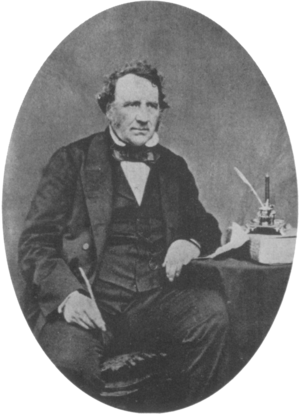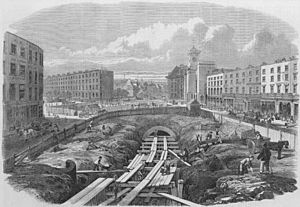Charles Pearson facts for kids
Quick facts for kids
Charles Pearson
|
|
|---|---|

Pearson, c. 1855
|
|
| Solicitor to the City of London | |
| In office 1839–1862 |
|
| Member of Parliament for Lambeth |
|
| In office 31 July 1847 – July 1850 |
|
| Preceded by | Benjamin Hawes |
| Succeeded by | William Williams |
| Councilman of the Corporation of London | |
| In office 1817–1820 |
|
| Constituency | Bishopsgate |
| In office 1830–1836 |
|
| Constituency | Bishopsgate |
| Personal details | |
| Born | 4 October 1793 City of London, England |
| Died | 14 September 1862 (aged 68) Wandsworth, England |
| Political party | Liberal |
| Other political affiliations |
Radicals |
| Spouse |
Mary Martha Dutton
(m. 1817) |
| Children | 1 |
| Occupation | Lawyer |
| Known for | Transport campaigner |
Charles Pearson (born 4 October 1793 – died 14 September 1862) was an important British lawyer and politician. He worked as a solicitor for the City of London. He was also a strong supporter of many reforms. For a short time, he was a Member of Parliament for Lambeth with the Liberal Party.
Pearson fought against unfair practices like how juries were chosen. He also pushed for changes in prisons and wanted to end the death penalty. He believed everyone should have the right to vote.
As the City Solicitor, Pearson worked hard to improve transport. He first suggested a big central railway station for London. This station would be underground and used by many train companies. This would let people travel easily into the city for work. When this idea didn't happen, Pearson promoted an underground railway. This railway would connect the main train stations in London's north. This project became the Metropolitan Railway, the world's first underground railway. It helped create the huge London Underground network we know today. This also led to London growing much bigger, very quickly.
Contents
Early Life and Education
Charles Pearson was born on 4 October 1793. His family lived at 25 Clement's Lane in the City of London. His father, Thomas Pearson, was an upholsterer and feather merchant. Charles went to school in Eastbourne. He was supposed to follow his father's trade. Instead, he chose to study law. He became a qualified solicitor in 1816.
In 1817, he married Mary Martha Dutton. They had one child, Mary Dutton Pearson, who was born in 1820.
City Career and Campaigns for Change
In 1817, Pearson was chosen as a councilman for the City of London Corporation. He represented the Bishopsgate area. He served in this role from 1817 to 1820, and again from 1830 to 1836. From 1831 to 1833, he led the City's health board. In 1839, he stopped his private law work. He then became the official City Solicitor, a job he held until he died.
Even though he came from a comfortable background, Pearson was a "radical." This meant he wanted big changes in society. He spent his life fighting for many important causes:
- He wanted to remove a message from the Monument. This message unfairly blamed Catholics for the Great Fire of London.
- He fought to stop "packed" juries. These were special juries chosen to get a certain outcome in political trials.
- He worked to allow Jews to become brokers in the City. This was not allowed before.
- He supported separating the Church of England from the government.
- He was against the death penalty.
- He believed in universal suffrage, meaning everyone should have the right to vote.
- He wanted to make parliamentary areas (constituencies) more equal in size.
- He tried to break the control that gas companies had. He thought the gas pipes should be owned by the public.
Pearson was a member of the Liberal Party. In 1847, he was elected as a Member of Parliament for Lambeth. He ran for this position because he wanted to push for prison reforms in parliament. He left his seat in 1850.
Campaigning for an Underground Railway
Pearson saw that London was getting very crowded. The City and its nearby areas were growing fast. In 1845, he wrote a paper suggesting an underground railway. This railway would run through the Fleet valley to Farringdon. He imagined trains pushed by compressed air. People made fun of this idea, and it never happened. But Pearson kept pushing for railway plans throughout the 1840s and 1850s.
In 1846, Pearson suggested a large central railway station for London. The City of London Corporation supported his idea. This station would be in Farringdon and cost about £1 million. Many railway companies would share it. Trains would reach it through a covered trench. Pearson wanted this plan to help City workers. He hoped it would let them live in good, cheap homes outside London. They could then travel into the city easily on affordable trains. However, a special committee in 1846 rejected this idea. They decided that no new railway lines should go into the very center of London.
In 1854, another committee looked at new railway ideas for London. Pearson suggested a railway that would connect London's main train stations. He showed them a survey of traffic coming into London. This survey proved how much traffic jams were caused by many carts, cabs, and buses. Pearson explained that the city was overcrowded because:
- More people were living in and around London.
- Many travelers from other parts of the country arrived at northern London train stations. They then caused traffic with buses and cabs trying to reach the city center.
- A large number of people now traveled between the countryside and the city every day for work.
Many of the proposed plans were rejected. But the committee did recommend a railway. This railway would link the main stations with the docks and the General Post Office. A special law for the Metropolitan Railway was approved on 7 August 1854. This railway would run between Praed Street in Paddington and Farringdon.
Pearson was not a director or a major investor in the new company. But he continued to support the project. He used his influence to help the company raise the £1 million needed to build the line. He wrote a pamphlet encouraging people to invest. He even convinced the City of London to invest. He argued that the railway would help with the city's traffic problems. Once the railway was running, the City sold its shares and made a profit.
By 1860, enough money was raised, and the final route was chosen. Building the railway began. It took less than three years to dig through some of London's poorest areas and under its busiest streets.
Pearson died on 14 September 1862, from a condition called dropsy (fluid retention). He passed away at his home in Wandsworth. He did not live to see the Metropolitan Railway open on 10 January 1863. He had refused a reward from the railway company. But after the railway opened, his wife was given £250 a year.
He was buried at West Norwood Cemetery on 23 September 1862.
His Lasting Impact
Many experts believe Charles Pearson has the strongest claim to being the first person to suggest an underground railway. He wanted to solve London's traffic problems. Michael Robbins, a transport historian, said that without Pearson's constant effort, the Metropolitan Railway might not have been built when it was. This railway was the first of its kind and the start of London's underground system.
When the Metropolitan Railway opened, it greatly reduced street traffic, especially cabs and buses. However, these quickly returned to their previous levels. This was despite the Metropolitan Railway carrying over 9 million passengers in its first year! The Metropolitan Railway was the world's first underground system. Other cities didn't adopt the idea until 1896, when the Budapest Metro and the Glasgow Subway opened.
Without Pearson promoting the idea of an underground railway when he did, it's possible the idea might have been forgotten. Other transport ideas, like electric trams and cars, might have taken over. The underground network allowed London to grow hugely and quickly. The population of what is now Greater London increased from about 3 million in 1861 to over 6 million in 1901.



